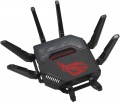Add to comparison |  |  |
|---|---|---|
| Asus ROG Rapture GT-BE98 Pro | Asus ROG Rapture GT-BE98 | |
| Compare prices 3 | Outdated Product | |
| TOP sellers | ||
AiProtection Pro is a built-in network protection technology. The overall WiFi speed is up to 30,000 Mbit/s. A powerful processor, 2 GB of RAM, Dual WAN and 10 Gbps ports for maximum connection stability and reliability. Speed priority for games. Game port. Built-in technology to reduce ping in games. Mobile gaming mode - prioritizes traffic via WiFi. | AiProtection Pro is a built-in network protection technology. The overall WiFi speed is up to 25,000 Mbit/s. A powerful processor, 2 GB of RAM, Dual WAN and 10 Gbps ports for maximum connection stability and reliability. Speed priority for games. Game port. Built-in technology to reduce ping in games. Mobile gaming mode - prioritizes traffic via WiFi. | |
| Product type | gaming router | gaming router |
| Data input (WAN-port) | Ethernet (RJ45) Wi-Fi 3G modem (USB) 4G (LTE) modem (USB) | Ethernet (RJ45) Wi-Fi 3G modem (USB) 4G (LTE) modem (USB) |
Wireless Wi-Fi connection | ||
| Wi-Fi standards | Wi-Fi 3 (802.11g) Wi-Fi 4 (802.11n) Wi-Fi 5 (802.11ac) Wi-Fi 6 (802.11ax) Wi-Fi 6E (802.11ax) Wi-Fi 7 (802.11be) | Wi-Fi 3 (802.11g) Wi-Fi 4 (802.11n) Wi-Fi 5 (802.11ac) Wi-Fi 6 (802.11ax) Wi-Fi 6E (802.11ax) Wi-Fi 7 (802.11be) |
| Frequency band | 2.4GHz 5 GHz 6 GHz | 2.4GHz 5 GHz 6 GHz |
| Operating ranges | tri-band (2.4 GHz, 5 GHz, 6 GHz in 2 channels) | tri-band (2.4 GHz, 5 GHz in 2 channels, 6 GHz) |
| Wireless speed 2.4 GHz | 1376 Mbps | 1376 Mbps |
| Wireless speed 5 GHz | 5764 Mbps | 11528 Mbps |
| Wireless speed 6 GHz | 23058 Mbps | 11529 Mbps |
| Bandwidth | 320 MHz | 320 MHz |
Connection and LAN | ||
| LAN | 7 ports 1 Gbps, 2.5 Gbps, 10 Gbps | 7 ports 1 Gbps, 2.5 Gbps, 10 Gbps |
| Reassignable WAN / LAN | 2 ports | 2 ports |
| USB 2.0 | 1 | 1 |
| USB 3.2 gen1 | 1 | 1 |
Antenna and transmitter | ||
| Number of antennas | 8 | 8 |
| Antenna type | external | external |
| MU-MIMO | ||
| 2.4 / 5 GHz antennas | 4 | 4 |
| 6 GHz antennas | 4 | 4 |
Hardware | ||
| CPU cores | 4 | 4 |
| Clock Speed | 2.6 GHz | 2.6 GHz |
| RAM | 2 GB | 2 GB |
| Flash memory | 256 MB | 256 MB |
Functions | ||
| Features | load balancing (Dual WAN) channel reservation Link Aggregation NAT repeater MESH mode Beamforming firewall | load balancing (Dual WAN) channel reservation Link Aggregation NAT repeater MESH mode Beamforming firewall |
| More features | DHCP server FTP server file server media server (DLNA) torrent client VPN DDNS DMZ | DHCP server FTP server file server media server (DLNA) torrent client VPN DDNS DMZ |
Security | ||
| Safety standards | WPA WEP WPA2 WPA3 802.1x | WPA WEP WPA2 WPA3 802.1x |
General | ||
| Lighting | RGB | RGB |
| Dimensions | 350x350x221 mm | 350x350x221 mm |
| Weight | 2000 g | 2000 g |
| Color | ||
| Added to E-Catalog | november 2023 | november 2023 |